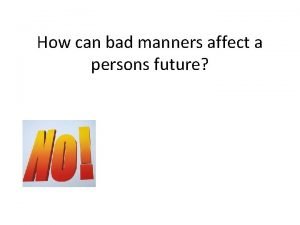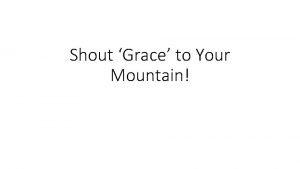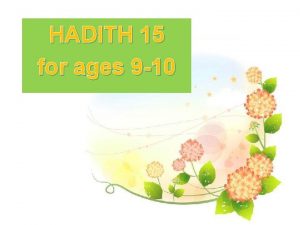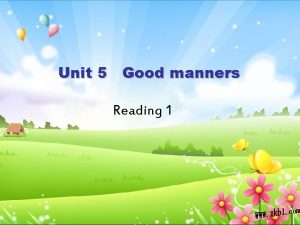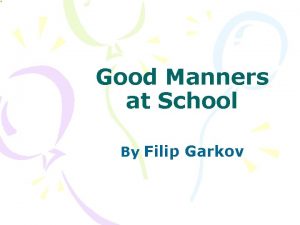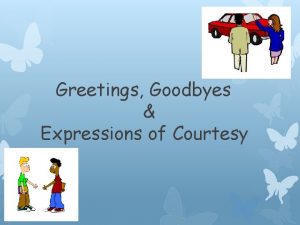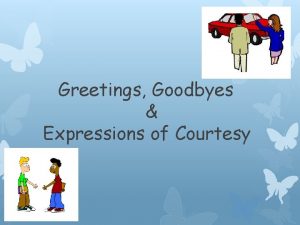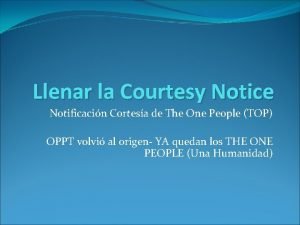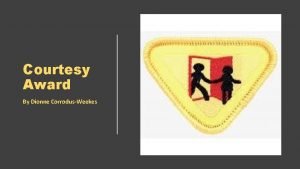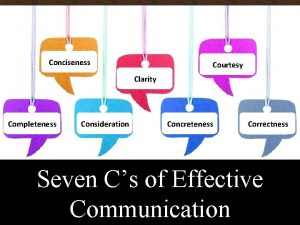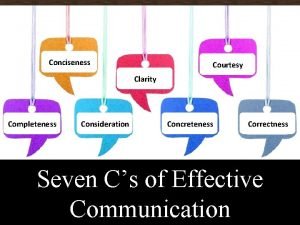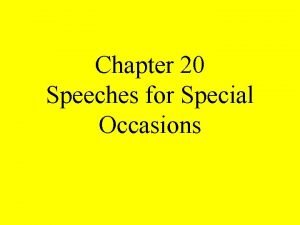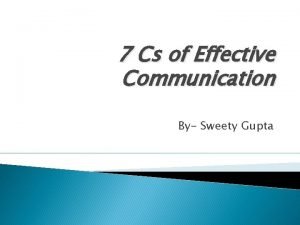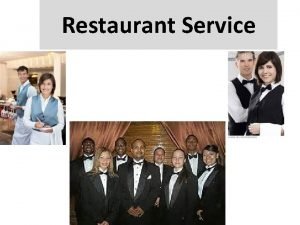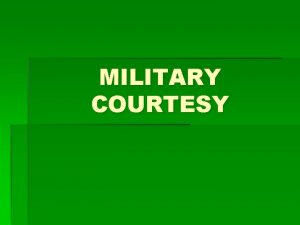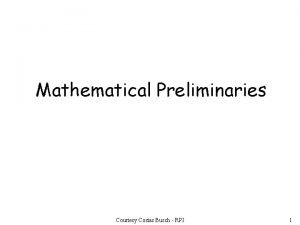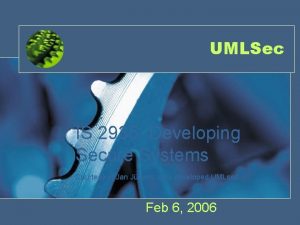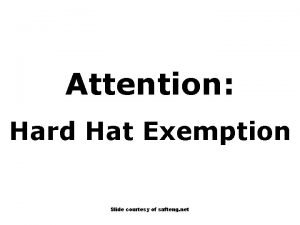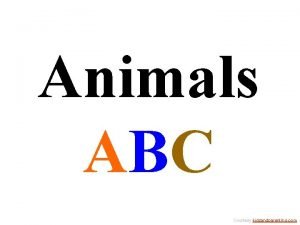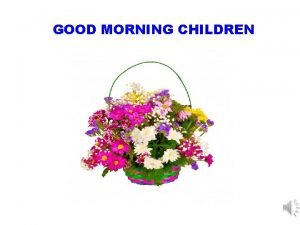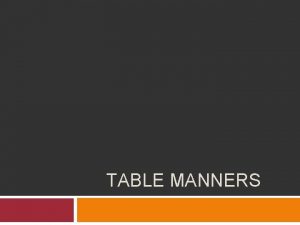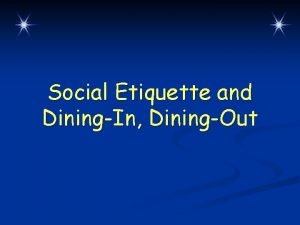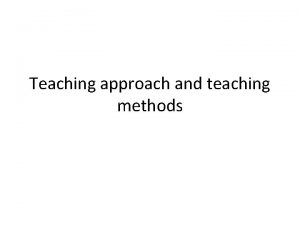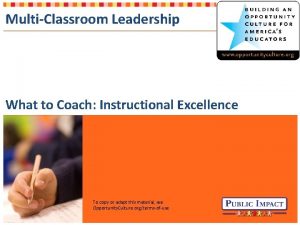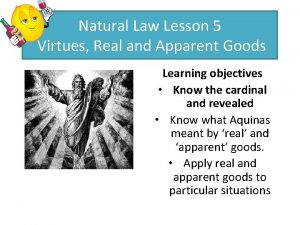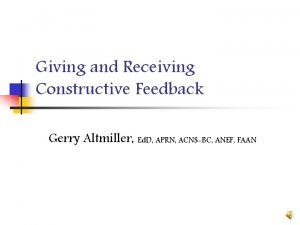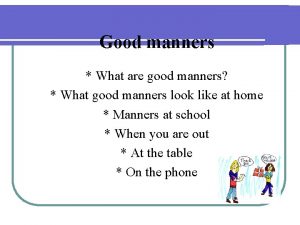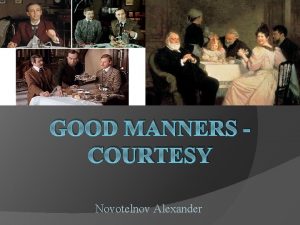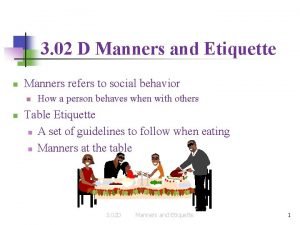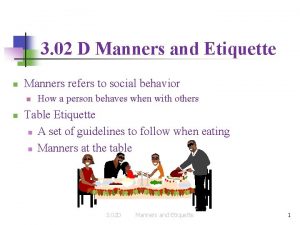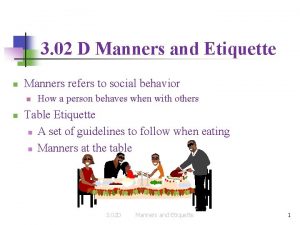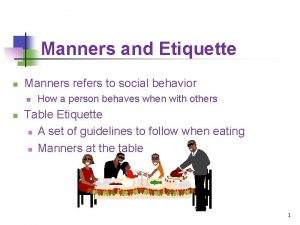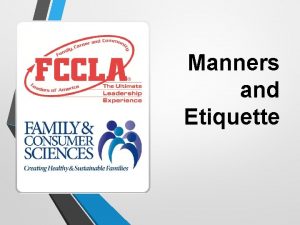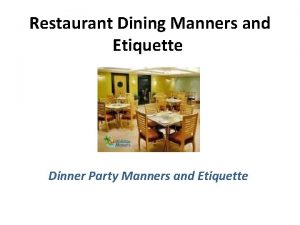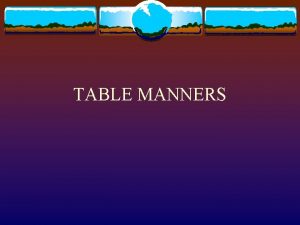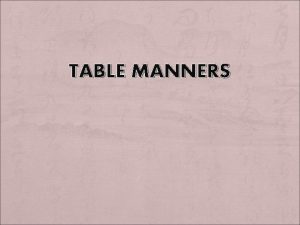Teaching Children Good Manners Grace and Courtesy Cathleen


























































- Slides: 58

Teaching Children Good Manners, Grace, and Courtesy Cathleen Haskins www. montessoriwise. com

Table and Food Manners

Language for Respect and Kindness

Social Manners

Teaching Methods • • Direct Teach Role Play Real Life Situations Puppetry Modeling Songs and Poems Picture Books

Table and Food Manners • Language • Skills

Table and Food Manners Saying yes please, or no thank you • Teacher to assistant, “Would you like to have a cracker? ” • Assistant, “Yes please. ” • Pause and repeat, this time assistant replies, “No thank you. ” • Offer each child a cracker. They reply with yes please, or no thank you.

Table and Food Manners Wait for everyone to be served before you begin eating.

Table and Food Manners May I have. . . • Make sure your mouth isn’t full • Raise your hand • Say, “May I have (another apple slice), please. ” • Don’t forget, “Thank you. ”

Table and Food Manners Using a napkin At the table: • Give each child a napkin • Invite children to place napkin on lap. • Demonstrate how to use by dabbing the corner of the mouth. • Return napkin to lap. • When finished, place napkin next to plate. Cloth vs. Paper Napkins

Or This

Table and Food Manners Mirrors for self checking

Table and Food Manners Chewing with your mouth closed Not talking while chewing food • At snack assistant asks the teacher, who has food in her mouth, a question. • Teacher points out she is eating and waits until she is done to reply. • Explain to children.

Table and Food Manners Feeling full • Place utensils and napkin on plate or table. • “That was delicious, but now I’m full. ” • “I am satisfied, thank you. ”

Table and Food Manners Burping etiquette Circle Time/Role Play • Take a sip of water. • Force yourself to burp, covering your mouth. • Say, excuse me. ” (About giggling…)

Table and Food Manners Removing food crumbs from the table

Crumbing Activity

Elbows off the table Fingers off the food Ask for something to be passed For reaching is so rude.

New School Table Manners http: //www. youtube. com/watch? v=Cc. ZYQt 1 g. Uh. Y

Award-Winning Elizabeth Verdik Toddler Board Book

Carrie Finn 3 -5 years

Karen Lefranc 5 -8 years

Mike Nawrocki 2 -6 years

Stan & Jan Berenstain 3 years and up

Aliki 3 years and up

Norman Bridwell 3 years and up

http: //www. amazon. com/Excuse. Me-Lisa. Kopelke/dp/0689851111/ref=sr_1_ 3? s=books&ie=UTF 8&qid=1334001 686&sr=1 -3

Language for Respect and Kindness “I like the way you do Teaching children that. ” to affirm one another Give children an opportunity to affirm each other. Make time for affirmation sharing. “You’re a good friend. ” “ You are so helpful (kind, generous, peaceful). ”

Language for Respect and Kindness When someone may need help: “Are you Okay? Can I help you? ” About repetition.

Language for Respect and Kindness When someone is having trouble or is sad: “What’s wrong? ” “Is there anything I can do to help? ” • Teach the word compassion.

Language for Respect and Kindness When a child wants to join an activity: “May I join, please? ”

Language for Respect and Kindness When the answer is no: “Not right now, thank you. ” “Maybe another time. ” “I’d rather be alone, thanks. ”

Language for Respect and Kindness Asking for a turn “May I have a turn, please. ” Waiting for a response

Language for Respect and Kindness When a child needs assistance: “Can you please help me? ”

Language for Respect and Kindness When you didn’t hear something: “Excuse me? ” “Pardon me? ”

Language for Respect and Kindness When a child has returned after being gone “I missed you. ” “Everybody missed you. ” “I’m glad you’re back. ” “It’s better when you’re here. ”

Language for Respect and Kindness Encouraging gentleness: With a young child, stroke their arm and say softly, “Gentle, gentle please. ” Demonstrating with a small animal works well to teach this lesson. Tone of voice.

Language for Respect and Kindness Speaking softly • Silence Game • Use a Radio or CD Player

Language for Respect and Kindness Lending (or sharing) something: “Would you like to borrow (my book, this toy)? “Yes, that would be nice. ” After receiving the item, “Thank you. ”

Language for Respect and Kindness Asking for something back “Are you finished with my book? ” “May I have my book back, please. ”

Language for Respect and Kindness Showing Regret or Remorse: • Look the person in the eye. • Speak slowly “I’m really very sorry. ” “What can I do to make it up to you? ”

Language for Respect and Kindness Asking for the teacher (adult’s) attention when he is busy: • • Is the teacher with someone? Is the teacher working on something? Stand nearby, but not too close. Wait until the teacher gives eye contact. Teaching about eye contact

Language for Respect and Kindness “I’m sorry to interrupt, but …”

Language for Respect and Kindness When another child is busy: • • Is the child with someone? Is the child working on something? Stand nearby, but not too close. Wait until the child turns and gives eye contact to speak. “Excuse me…”

Social Manners Blowing your nose: T • Pull tip of tissue to get a tissue from the box. • Fold tissue in half. • Cover nose and blow. • Fold tissue and dab nose. “Today I’m going to show you how to blow your nose. ” • Throw tissue in bin.



Social Manners Sneezing and coughing: • Look away and down. • Move away from food. • Cover mouth with tissue and cough. • Dispose of tissue. “Today I’m going to show you how to sneeze. ” • Or, sneeze into elbow.

Social Manners Dealing with gas: Simply say, “Excuse me. ” Or, move away if you can.



Social Manners Polite yawn: Cover your mouth. Use a quiet voice.

Social Manners Putting others first/ after you: “After you. ”

Social Manners Ask or answer a question in circle time: • Stay seated. • Make no sound. • Keep your hand below • You head.

Social Manners Lining up: “As quiet as a deer in the woods. ” “Be like a butterfly. ”

Social Manners Closing a door quietly: The teacher stands at the door, and whispers the children's names. When the child hears his name being called, he will rise up and go to the door and open the door as silently as he is able.

Social Manners Closing a drawer carefully: You will need a small chest of drawers. Invite children to listen and watch closely. • Place both hands on knobs and gently pull open. • Put both hands, fingers flat, against the open • drawer. • Push gently and slide the drawer back in.

 The circus animals' desertion
The circus animals' desertion Cathleen ni houlihan
Cathleen ni houlihan Cathleen tobin
Cathleen tobin Not good manners
Not good manners Definition of sanctifying grace
Definition of sanctifying grace With shouts of grace grace to it
With shouts of grace grace to it Once in grace always in grace
Once in grace always in grace Manners cartoon
Manners cartoon Good manners summary
Good manners summary Hadith 15 of annawawis collection
Hadith 15 of annawawis collection Good manners
Good manners Good manners
Good manners Good manners by jc hill
Good manners by jc hill Good thoughts good words good deeds
Good thoughts good words good deeds B. good evening
B. good evening Hello good afternoon teacher
Hello good afternoon teacher If you are
If you are Hello teacher good afternoon
Hello teacher good afternoon Expressions of courtesy
Expressions of courtesy Greetings farewells and courtesy expressions en español
Greetings farewells and courtesy expressions en español Grace is a good citizen!
Grace is a good citizen! Teaching children joy
Teaching children joy Definition of microteaching
Definition of microteaching Courtesy notice
Courtesy notice Courtesy award
Courtesy award Clarity and completeness
Clarity and completeness 7 c's of communication correctness
7 c's of communication correctness Character trait of the week
Character trait of the week Speech of courtesy
Speech of courtesy Respect and attitude
Respect and attitude Completeness in effective communication
Completeness in effective communication Service courtesy
Service courtesy Expression of courtesy
Expression of courtesy Professional courtesy examples
Professional courtesy examples Empirical formula to percent composition
Empirical formula to percent composition Percent composition of magnesium carbonate
Percent composition of magnesium carbonate Courtesy
Courtesy Courtesy
Courtesy Courtesy
Courtesy Courtesy
Courtesy Slide courtesy
Slide courtesy Empirical formula from percentages
Empirical formula from percentages Courtesy hor
Courtesy hor Slide courtesy
Slide courtesy Coe 202
Coe 202 Safteng
Safteng Courtesy
Courtesy International place value system in maths
International place value system in maths Manners and etiquette vocabulary
Manners and etiquette vocabulary Christian grooming and manners honor powerpoint
Christian grooming and manners honor powerpoint Manners in pride and prejudice
Manners in pride and prejudice Restoration comedy comedy of manners
Restoration comedy comedy of manners What is the first rule in social correspondence
What is the first rule in social correspondence Characteristics of good teaching methods
Characteristics of good teaching methods Instructional excellence
Instructional excellence You are good you are good and your love endures
You are good you are good and your love endures Law is order and good law is good order
Law is order and good law is good order Example of real and apparent good
Example of real and apparent good How do i get feedback with grace and dignity
How do i get feedback with grace and dignity



